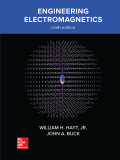
Engineering Electromagnetics
9th Edition
ISBN: 9781260029963
Author: Hayt
Publisher: MCG
expand_more
expand_more
format_list_bulleted
Question
Chapter 7, Problem 7.9P
To determine
(a)
The total current flowing.
To determine
(b)
The magnetic field H at origin.
Expert Solution & Answer
Want to see the full answer?
Check out a sample textbook solution
Students have asked these similar questions
A 2000 kVA,Y- connected alternator gives an open circuit line voltage of 3.3 kV for a field current of
65 A. For same field current the short circuit current is being equal to full load current. Calculate the full
load voltage regulation at both 0.8 lagging p.f. and unity p.f., neglect armature resistance?
Don't use ai to answer I will report you answer
Don't use ai to answer I will report you answer
Chapter 7 Solutions
Engineering Electromagnetics
Ch. 7 - Find H in rectangular components at P(2,3,4) if...Ch. 7 - Prob. 7.2PCh. 7 - Prob. 7.3PCh. 7 - Prob. 7.4PCh. 7 - The parallel filamentary conductors shown in...Ch. 7 - A disk of radius a lies in the xy plane, with z...Ch. 7 - Prob. 7.7PCh. 7 - For the finite-length current element on the z...Ch. 7 - Prob. 7.9PCh. 7 - Prob. 7.10P
Ch. 7 - A solenoid of radius a and of length. L is...Ch. 7 - Prob. 7.12PCh. 7 - Prob. 7.13PCh. 7 - Prob. 7.14PCh. 7 - Prob. 7.15PCh. 7 - A current filament carrying I in the -az direction...Ch. 7 - Prob. 7.17PCh. 7 - Prob. 7.18PCh. 7 - Prob. 7.19PCh. 7 - A solid conductor of circular cross section with a...Ch. 7 - Prob. 7.21PCh. 7 - Prob. 7.22PCh. 7 - Prob. 7.23PCh. 7 - Prob. 7.24PCh. 7 - Prob. 7.25PCh. 7 - Prob. 7.26PCh. 7 - The magnetic field intensity is given in a certain...Ch. 7 - Given H=(3r2/sin)a+54rcosa A/m in free space: (a)...Ch. 7 - Prob. 7.29PCh. 7 - Prob. 7.30PCh. 7 - Prob. 7.31PCh. 7 - Prob. 7.32PCh. 7 - Use an expansion in rectangular coordinates to...Ch. 7 - A filamentary conductor on the z axis carries a...Ch. 7 - A current sheet K = 20 az A/m, is located at p =...Ch. 7 - Let A= (3y-z)ax+2xzayWb/m in a certain regin of...Ch. 7 - Let/N=1000, I=.08 A, p0=2 cm and a=.08 cm for the...Ch. 7 - A square filamentary differential current loop, dL...Ch. 7 - Prob. 7.39PCh. 7 - Show that the line integral of the vector...Ch. 7 - Prob. 7.41PCh. 7 - Show that 2(1/R12)=1(1/R12)=R21/R312.Ch. 7 - Compute the vector magnetic potential within the...Ch. 7 - Prob. 7.44P
Knowledge Booster
Similar questions
- What is motorarrow_forwardDon't use ai to answer I will report you answerarrow_forwardHow can I design a socket for a trolley headlight? What parameters should I measure? The only thing I have is the headlight itself, and I don’t have any information about its power, current, or voltage rating. The power source is 120 V, and my goal is simply to get the headlight to turn on.I’m not sure where to start or what to measure. Any recommendations would be greatly appreciated!arrow_forward
- Figure 2 3) *** The circuit of Figure 3 is designed with W/L = 20/0.18, λ= 0, and ID = 0.25 mA. (Optional- 20 points) a) Compute the required gate bias voltage. b) With such a gate voltage, how much can W/L be increased while M1 remains in saturation? What is the maximum voltage gain that can be achieved as W/L increases? VDD = 1.8 V RD 2k - Vout Vin M₁ Figure 3arrow_forward1) Rs = 4kQ, R₁ = 850 kQ, R₂ = 350 kQ, and R₁ = 4 kQ. The transistor parameters are VTP = -12 V, K'p = 40 µA / V², W/L = 80, and λ = 0.05 V-1. (50 Points) a) Determine IDQ and VSDQ. b) Find the small signal voltage gain. (Av) c) Determine the small signal circuit transconductance gain. (Ag = io/vi) d) Find the small signal output resistance. VDD = 10 V 2'; www www Figure 1 Ссarrow_forwardQ11arrow_forward
arrow_back_ios
SEE MORE QUESTIONS
arrow_forward_ios
Recommended textbooks for you
 Introductory Circuit Analysis (13th Edition)Electrical EngineeringISBN:9780133923605Author:Robert L. BoylestadPublisher:PEARSON
Introductory Circuit Analysis (13th Edition)Electrical EngineeringISBN:9780133923605Author:Robert L. BoylestadPublisher:PEARSON Delmar's Standard Textbook Of ElectricityElectrical EngineeringISBN:9781337900348Author:Stephen L. HermanPublisher:Cengage Learning
Delmar's Standard Textbook Of ElectricityElectrical EngineeringISBN:9781337900348Author:Stephen L. HermanPublisher:Cengage Learning Programmable Logic ControllersElectrical EngineeringISBN:9780073373843Author:Frank D. PetruzellaPublisher:McGraw-Hill Education
Programmable Logic ControllersElectrical EngineeringISBN:9780073373843Author:Frank D. PetruzellaPublisher:McGraw-Hill Education Fundamentals of Electric CircuitsElectrical EngineeringISBN:9780078028229Author:Charles K Alexander, Matthew SadikuPublisher:McGraw-Hill Education
Fundamentals of Electric CircuitsElectrical EngineeringISBN:9780078028229Author:Charles K Alexander, Matthew SadikuPublisher:McGraw-Hill Education Electric Circuits. (11th Edition)Electrical EngineeringISBN:9780134746968Author:James W. Nilsson, Susan RiedelPublisher:PEARSON
Electric Circuits. (11th Edition)Electrical EngineeringISBN:9780134746968Author:James W. Nilsson, Susan RiedelPublisher:PEARSON Engineering ElectromagneticsElectrical EngineeringISBN:9780078028151Author:Hayt, William H. (william Hart), Jr, BUCK, John A.Publisher:Mcgraw-hill Education,
Engineering ElectromagneticsElectrical EngineeringISBN:9780078028151Author:Hayt, William H. (william Hart), Jr, BUCK, John A.Publisher:Mcgraw-hill Education,

Introductory Circuit Analysis (13th Edition)
Electrical Engineering
ISBN:9780133923605
Author:Robert L. Boylestad
Publisher:PEARSON

Delmar's Standard Textbook Of Electricity
Electrical Engineering
ISBN:9781337900348
Author:Stephen L. Herman
Publisher:Cengage Learning

Programmable Logic Controllers
Electrical Engineering
ISBN:9780073373843
Author:Frank D. Petruzella
Publisher:McGraw-Hill Education

Fundamentals of Electric Circuits
Electrical Engineering
ISBN:9780078028229
Author:Charles K Alexander, Matthew Sadiku
Publisher:McGraw-Hill Education

Electric Circuits. (11th Edition)
Electrical Engineering
ISBN:9780134746968
Author:James W. Nilsson, Susan Riedel
Publisher:PEARSON

Engineering Electromagnetics
Electrical Engineering
ISBN:9780078028151
Author:Hayt, William H. (william Hart), Jr, BUCK, John A.
Publisher:Mcgraw-hill Education,